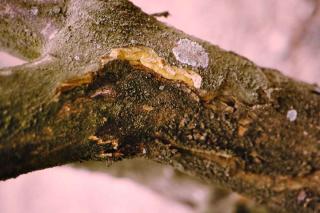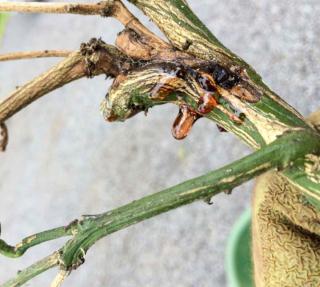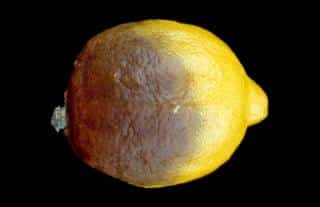

For citrus trees, root rot leads to trunk rot. It’s sometimes detected on fruits, too. The disease results from an infection by Phytophthora, a rot fungus.
Root rot is definitely a gardener’s worst nightmare – especially when it starts infecting citrus trees.
A special micro-organism called Phytophthora is responsible for this disease. When the soil is too wet, it infects roots and they start rotting.
Some experts call it “citrus mildew“, but confusing since another citrus disease caused by Oidium also has the same name.
A big problem with this disease is that symptoms only appear very late:
In cases like these, the culprit is Phytophthora, a soil inhabitant. It infects trees, wood plants, and even vegetables. For instance, it also causes tomato blight that doesn’t stop until the entire crop is devastated.
 It’s spread by water, either through contact with the tree’s bark (during heavy rains, for instance), or through fruits (those that are nearer the ground), as rain drops spatter back up. The peel then starts showing signs of damage. There are a great many different types of phytophthora. Some are triggered by warmth, whereas others are more potent when the weather is cool. Most of them appear in spring and in fall.
It’s spread by water, either through contact with the tree’s bark (during heavy rains, for instance), or through fruits (those that are nearer the ground), as rain drops spatter back up. The peel then starts showing signs of damage. There are a great many different types of phytophthora. Some are triggered by warmth, whereas others are more potent when the weather is cool. Most of them appear in spring and in fall.
On citrus trees, it’s (sad to say) very easy to identify citrus root rot:
 my sap. It bursts open in places and brown wounds form.
my sap. It bursts open in places and brown wounds form.Usually, it takes years for the tree to slowly wane, and then it suddenly dies. On a young tree, the disease spreads particularly fast.
Double-ridge watering: citrus trees hate getting water at the base of the trunk (root crown). This is because water often brings on disease. The root crown is a vulnerable spot because the bark is much thinner there. A “double ridge” is a means to protect the trunk from getting touched by water even when there’s a lot of it, like during heavy rains. An inside ridge keep water from reaching the trunk, while an outside ridge channels water to roots all around the tree: it’s set 2-3 feet out beyond the drip line (50-80cm).
 Eliminate sick fruits and any leaves and branches that fall to the ground.
Eliminate sick fruits and any leaves and branches that fall to the ground.Just like animals (and, of course, us humans), citrus trees can and do fall victim to diseases because of fungus, viruses, or lack of nutrients (vitamins, trace minerals…). Such issues have consequences that are often much more critical than those caused by pests and parasites.
In previous times, even until recently, what is called Phytophthora was thought to be a fungus. Nowadays it’s been classified as an Oomycete. This is a life form that looks like a fungus, but is actually genetically related to algae. Even though this might seem to be a detail, this new understanding is already opening inroads into new forms of treatment. Let’s hope they’re made available soon!